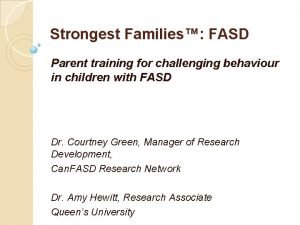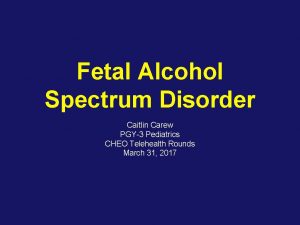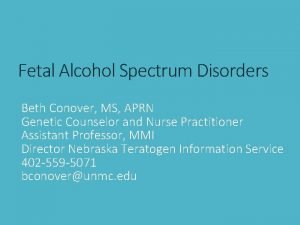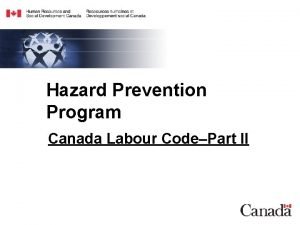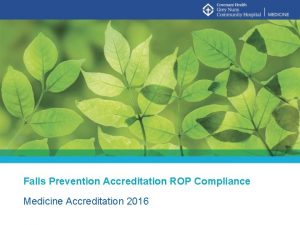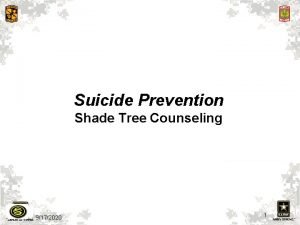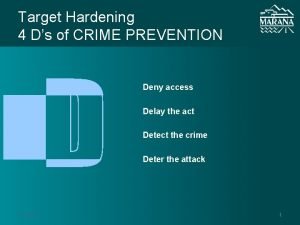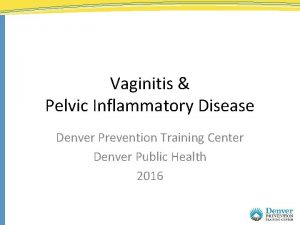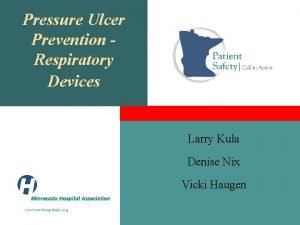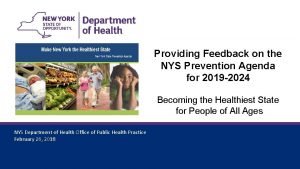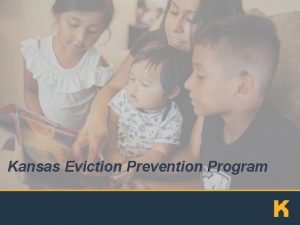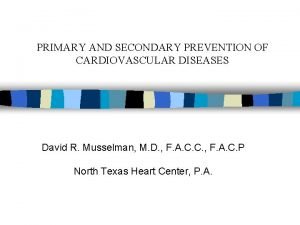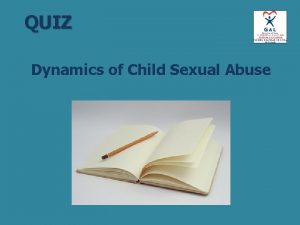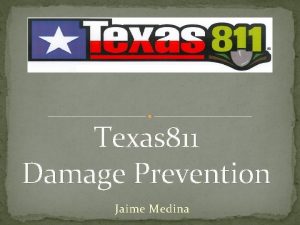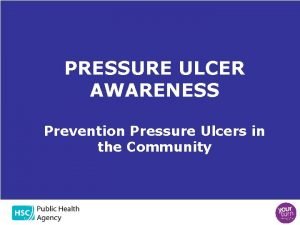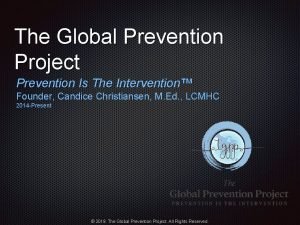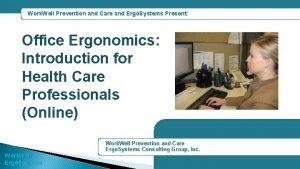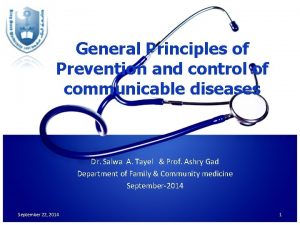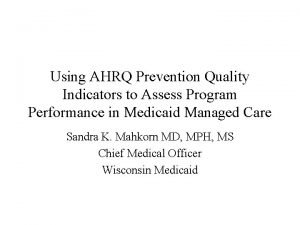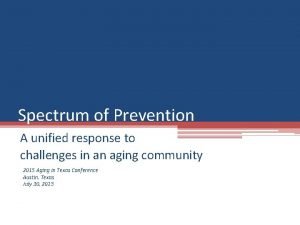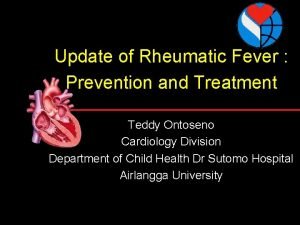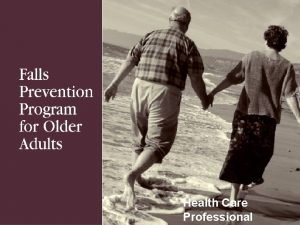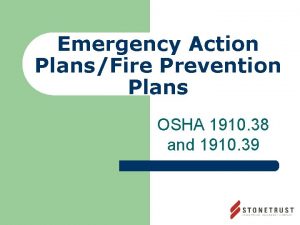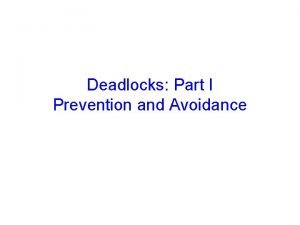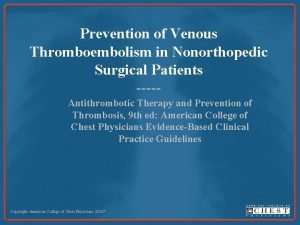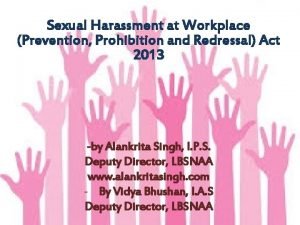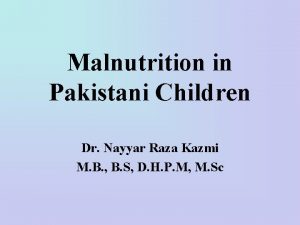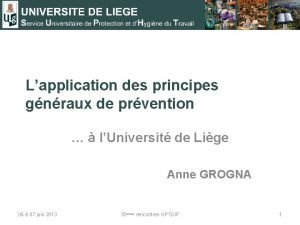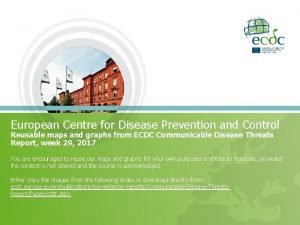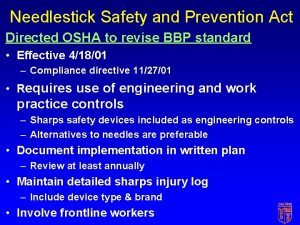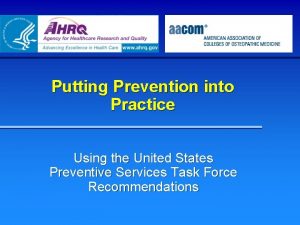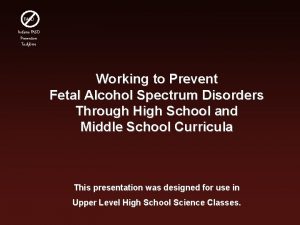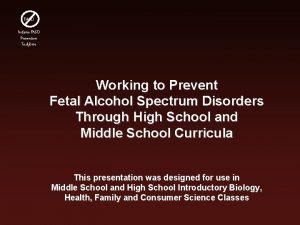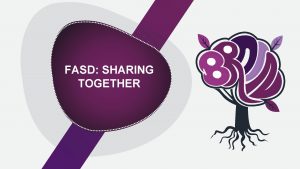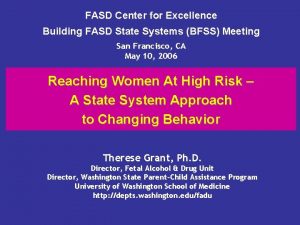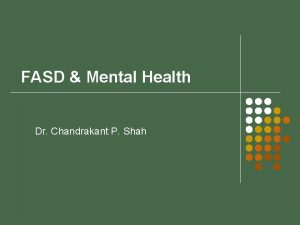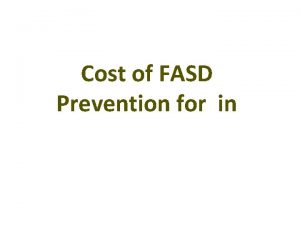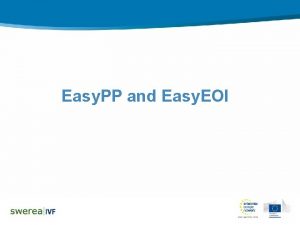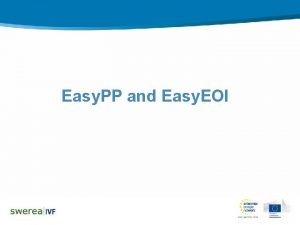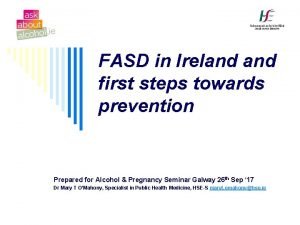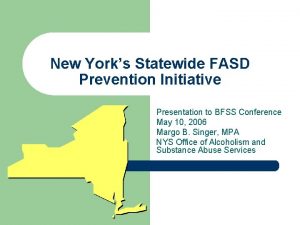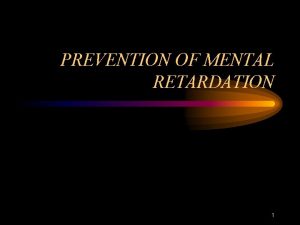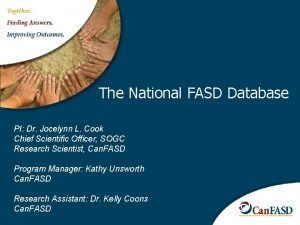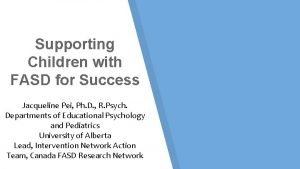Prevention of FASD Is It As Easy As




















































- Slides: 52

Prevention of FASD Is It As Easy As Telling Women Not To Drink? Mary Mueller, Region of Waterloo Public Health, R. N. , B. Sc. N. Waterloo Region FASD Community of Practice Wednesday May 13, 2015

FASD A Chronic Disease? A Chronic Disease is a non-communicable illness that is prolonged in duration, does not resolve spontaneously and is rarely completely cured • Preventable • Cannot be cured - lifelong • Four common health damaging but modifiable behaviours – tobacco use, insufficient physical activity, poor eating habits and excessive use of alcohol – are responsible for much of the illness, disability and premature death related to chronic diseases (Centre for Disease Control and Prevention – 2013)

What is the Cost to Society? § FASD affects 1% of the Canadian population § Many experts feel that the prevalence of FASD is much higher due to a lack of awareness about FASD in the medical community and a shortage of diagnostic services § Public Health Agency of Canada estimates 5. 3 billion dollars are spent annually to support those with FASD (birth to age 53) § Can. FASD a Canadian research network estimates the annual cost to be 7. 6 billion ( Thanh and Jonsson) § 800, 000 - 1. 4 million dollars/individual is the estimated cost to support those affected with FASD over a life time § The rate of FASD in Canada’s prisons is estimated to be ten times higher than the general population

What is the Cost to Society? § 60% of people with FASD 12 years and older have been charged with/or convicted of a crime § 95% of those with FASD have a mental illness § Can FASD estimates that Canada would benefit greatly if we were to devote resources to the prevention of FASD § If we spent $150, 000 to prevent FASD we would save $1. 6 million (Can. FASD, 2013) John Howard Society, FASD Factsheet, 2010

Four Levels of Prevention Can. FASD Research Network (Adapted from Public Health Agency of Canada) Level 2 Discussion of alcohol use and related risks with all women of childbearing years and their support networks Level 1 Raising Awareness Health Promotion Fetal Alcohol Spectrum Disorder (FASD) Prevention: Canadian Perspectives. Public Health Agency of Canada, 2008. Prevention of Fetal Alcohol Spectrum Disorder: A Multi-Level Model. Can. FASD Research Network, 2013 Supportive Alcohol Policy Level 4 Support for: • New Mother • Child development and assessment Level 3 Specialized holistic support of pregnant women with alcohol and other health/social concerns

LEVEL 1 – RAISING AWARENESS/HEALTH PROMOTION § Important component of a comprehensive health promotion approach § Changing alcohol consumption patterns is complex § This level is the foundation for the other 3 levels of prevention § Provincial and local campaigns

Level 1 – What is Your Role? • Support local efforts on FASD Awareness Month • Increase knowledge with your own colleagues and agency staff • Help to challenge, present evidence and dispel ever prevalent myths • Post information on your website, your facebook page, twitter account etc.

Four Levels of Prevention Can. FASD Research Network (Adapted from Public Health Agency of Canada) Level 2 Discussion of alcohol use and related risks with all women of childbearing years and their support networks Level 1 Raising Awareness Health Promotion Fetal Alcohol Spectrum Disorder (FASD) Prevention: Canadian Perspectives. Public Health Agency of Canada, 2008. Prevention of Fetal Alcohol Spectrum Disorder: A Multi-Level Model. Can. FASD Research Network, 2013 Supportive Alcohol Policy Level 4 Support for: • New Mother • Child development and assessment Level 3 Specialized holistic support of pregnant women with alcohol and other health/social concerns

LEVEL 2 Discussion of alcohol use and related risks with all women of childbearing years and their support networks § Evidence indicates this is one of the most effective strategies to reduce alcohol exposed pregnancies (FASD ONE - Call to Action) § Health and social service providers (HCP) are seen as a credible source of information and their advice is likely to lead to behaviour change (SOGC - 2010) § 2009 – 43% of women and 32% of women planning a pregnancy in the next 2 years did not recall receiving any information about alcohol and pregnancy from their doctor (Best Start – 2009) § Need to shift the reproductive health lens to include preconception

Why Focus on Women and Alcohol Use? • Ontario: • Past Year Alcohol Consumption for Women* • 74. 6% - 2010 • 78. 9% in 2011 Ø 17. 1% reported exceeding the LRADG^ for women Ø Daily drinking rates for women increased from 2. 6% of women in 2001 to 5. 7% in 2011 Ø Hazardous/harmful drinking for women increased from 4. 8% in 1998 to 7. 9% in 2011 (Based on AUDIT Screen Score of 8+) Ø Binge drinking rates for young women have also increased in the last decade (5 or more drinks on a single occasion) • * Addiction and Mental Health Indicators Among Ontario Adults 1997 -2011, CAMH • ^LRADG – Low Risk Alcohol Drinking Guidelines

Why Focus on Women and Alcohol Use? § Alcohol affects women differently than men § If women consume alcohol above LRADG may increase their risk of chronic disease*, violence and injuries § Risky use of substances before pregnancy puts a woman at higher risk of alcohol use in pregnancy § Fetal Alcohol Spectrum Disorder (FASD) is caused by alcohol use in pregnancy *Chronic diseases – cancer, heart disease and stroke

National, Provincial and Local Statistics Waiting to Prevent FASD in Pregnancy is Too Late! § Rate of unintended pregnancy in Canada is estimated to be 40% (PHAC) § Women at highest risk of binge drinking 15 to 19 years of age, followed closely by those 20 -24 years of age § Highest rates of unintended pregnancy in 15 -19 year olds (82% of pregnancies in this age group did not intend to get pregnant) § 2009 Canadian Maternity Experiences Survey found 62. 4% of women drank 3 months preceding pregnancy, 10. 5% reported drinking in pregnancy § In Waterloo Health Unit area rate of heavy drinking was 16. 8% as compared to 15. 9% for the province of Ontario (Statistics Canada, January 2013) § In Waterloo Health Unit area rate of heavy drinking in females was 10. 1% as compared to 8. 6% for the province of Ontario(Statistics Canada, January 2013)

Canada's Low Risk Alcohol Drinking Guidelines What Is a Standard Drink? Beer 341 ml, 12 oz, 5% alcohol Wine 142 ml, 5 oz, 12% alcohol Liquor or Spirits 43 ml, 1. 5 oz, 40% alcohol • Women -2/day, 10 /week • Men – 3/day, 15/week • Non-drinking days every week to avoid developing a habit • Special Occasions - reduce your risk of injury and harm by drinking no more than 3 drinks (for women) Pregnant? Zero is Safest If you are pregnant or planning to become pregnant, or about to breastfeed, the safest choice is to drink no alcohol at all. http: //www. ccsa. ca

Target Groups That Require Different Approaches All Women/Men in their Childbearing Years Women struggling with Social Determinants of Health (lack of income, lack of education, lack of appropriate social support, in violent relationships, women with mental health issues, women who have had past trauma) Women who are working, more established career, waited until their career was more established to begin a family Important to address partner’s substance use

Strategies to Reduce Substance Use Women of Childbearing Age Independent Practice Women of Childbearing Years: Screening, Brief Intervention, Referral Begin Before Pregnancy Screen all women for substance/alcohol use issues Be aware of the current research regarding substances used and their related health risks Provide key messages to all women on Canada’s LRADG* (2 drinks/day, 10 drinks/week, 3 drinks/special occasion, no alcohol if pregnant, planning a pregnancy) Add in no alcohol if you suspect you are pregnant http: //www. rethinkyourdrinking. ca Emphasize that LRADG* are upper limits - if do not drink even better * LRADG – Low Risk Alcohol Drinking Guidelines

Strategies to Reduce Substance Use Women of Childbearing Age Independent Practice • • • Screening Tools: Assess if following/aware of LRADG Substance Abuse Screen T-ACE CAGE TWEAK

One Open Ended Question How does alcohol fit into your life?

Strategies to Reduce Substance Use Women of Childbearing Age Independent Practice T-ACE T Tolerance How many drinks does it take to make you feel high? A Annoyance Have people annoyed you by criticizing your drinking? C Cut Down Have you ever felt you need to cut down on your drinking? E Eye Opener Have you ever had a drink first thing in the morning to steady your nerves or to get rid of a hangover? Score 1 point for each Yes High Risk Score: 2 or more points (maximum 5 points) www. beststart. org/resources/alc_reduction/pdf/DR_alcohol. 08. pdf www. caphc. org – search Maternal Drinking Guide

Strategies to Reduce Substance Use Women of Childbearing Age

Strategies to Reduce Substance Use Women of Childbearing Age Independent Practice Women of Childbearing Years: If above LRADG* or screen positive on screen advise to cut back – offer referral to local service or online/phone support If using alcohol/substances assess how often, how much, reason for use, self perception of use Drug and Alcohol Helpline - http: //www. drugandalcoholhelpline. ca/ 1 -800 -565 -8603 Centre for Addiction and Mental Health http: //www. camh. ca/en/hospital/health_information/finding_help/Pages/finding_help. aspx Discuss use of reliable birth control that is easy to use to prevent alcohol/substance exposed pregnancy Multi-vitamin recommended for all women of childbearing age * LRADG – Low Risk Alcohol Drinking Guidelines

Strategies to Reduce Substance Use Women of Childbearing Age Consensus on 10 Fundamental Components of FASD Prevention from a Women’s Health Determinants Perspective Can. FASD originally Canada North. West FASD Research Network – February 2010 1. Respectful Respect is paramount to successful FASD prevention Helps to create conditions for women to discuss their experiences, identifying coping strategies and healing processes 2. Relational Women who are most at risk for having a child at risk of FASD experience some form of social disconnection Change and growth occurs through interactions with others that are long-term, supportive and based in trust This type of environment is important for the woman’s personal support networks and in relationships with care providers and support networks

Strategies to Reduce Substance Use Women of Childbearing Age Consensus on 10 Fundamental Components of FASD Prevention from a Women’s Health Determinants Perspective Can. FASD originally Canada North. West FASD Research Network – February 2010 3. Self-Determining Women have the right to determine and lead their own paths of growth and change the role of health care and other support systems in FASD prevention should be to support women’s autonomy, decision making, and control of resources 4. Women Centered In addition to the heath of the baby the woman’s health is important in and of itself Women are informed participants in their own health care, and attends to women’s overall health and safety Empowerment, safety, and social-justice - key considerations

Strategies to Reduce Substance Use Women of Childbearing Age Consensus on 10 Fundamental Components of FASD Prevention from a Women’s Health Determinants Perspective – Can. FASD originally Canada North. West FASD Research Network – February 2010 5. Harm Reduction Oriented Helps with immediate goals; provides variety of options/supports Focuses on both the substance use and on reducing the harms that are associated with use. 6. Trauma Informed Consider the influence of trauma/violence on health and interactions with others Practitioners need to understand trauma-related symptoms as a way to cope, and integrate this knowledge into service delivery and policy

Strategies to Reduce Substance Use Women of Childbearing Age Consensus on 10 Fundamental Components of FASD Prevention from a Women’s Health Determinants Perspective – Can. FASD originally Canada North. West FASD Research Network – February 2010 7. Health Promoting Addresses the social determinants of health and understands how they affect health FASD prevention strategy requires a holistic, multidisciplinary, cross-sectoral approach to be successful 8. Culturally Safe Need to feel respected, safe, and accepted for who they are, with respect to their cultural identity and personal behaviours Need to respect a person’s culture, values and preferences at every encounter

Strategies to Reduce Substance Use Women of Childbearing Age Consensus on 10 Fundamental Components of FASD Prevention from a Women’s Health Determinants Perspective – Can. FASD originally Canada North. West FASD Research Network – February 2010 9. Supportive of Mothering Supportive of women’s choices and roles as mothers, recognize the influences that a loss of custody may have on a woman – open to many options such as: part-time parenting, open adoption, kinship and elder support, shared parenting 10. Uses a Disability Lens Women with substance/mental health issues may also have disabilities, including FASD Need to consider her disabilities and accommodations when developing plan of care

LEVEL 2 – WHAT IS YOUR ROLE? Discussion of alcohol use and related risks with all women of childbearing years and their support networks • Screen for risky alcohol use with all women of childbearing age • Provide key messages regarding safer alcohol use • Discuss the importance of being on a reliable form of birth control if you are using any alcohol/substances • Link to services if needed

Four Levels of Prevention Can. FASD Research Network (Adapted from Public Health Agency of Canada) Level 2 Discussion of alcohol use and related risks with all women of childbearing years and their support networks Level 1 Raising Awareness Health Promotion Fetal Alcohol Spectrum Disorder (FASD) Prevention: Canadian Perspectives. Public Health Agency of Canada, 2008. Prevention of Fetal Alcohol Spectrum Disorder: A Multi-Level Model. Can. FASD Research Network, 2013 Supportive Alcohol Policy Level 4 Support for: • New Mother • Child development and assessment Level 3 Specialized holistic support of pregnant women with alcohol and other health/social concerns

Level 3 Specialized Holistic Support of Pregnant Women with Alcohol and Other Health/Social Concerns Moving Forward for women 18 years and over St. Mary's Counselling ≤ 18 years Healthy Babies, Healthy Children Often Family and Children's Services are involved Growing Healthy Two-gether Prenatal Nutrition Programs Places providing housing/support with SDOH like Marillac Place, Monica Place, O. W. , ROOF, Outreach Workers • Motherisk - 1 -877 -327 -4636 • Women may want to go outside of region for treatment • • •

OUTCOME OF PRENATAL SUBSTANCE USE EXPOSURE ON BABIES/CHILDREN Impact of alcohol on baby depends on: • When alcohol is consumed • How much is consumed • How often it is consumed May also depend on: • • Age Nutrition Determinants of health Genetic factors

Risk Factors for Alcohol Use in Pregnancy § Women who drink above the low risk drinking guidelines prior to getting pregnant – no more than 2 standard drinks/day or no more than 9 standard drinks/week § Pre-pregnancy binge drinking - binge drinking defined as 4+ drinks in 2 hours for an average sized female § Women using birth control unreliably § Women 35 years of age and older who work and drink socially § Having a partner who drinks § Low socioeconomic status – low income, low paying job, lower education, unstable housing, low social support Saskatchewan Prevention Institute, 2013

Risk Factors for Alcohol Use in Pregnancy § Mother with cognitive impairments – consider she may have undiagnosed FASD § Mental Health Issues § Mothers using tobacco or other substance more at risk of alcohol exposed fetus § Having a previous child who was exposed to alcohol in pregnancy Saskatchewan Prevention Institute, 2013

Prevalence of Substance Use Pregnancy • Alcohol - 11% of women consumed alcohol • Alcohol use in pregnancy is more commonly reported in older women • Tobacco - 13% of women smoked cigarettes • Tobacco use in pregnancy is more common in younger women • Illicit Drug Use - 5% of women reported illicit drug use • Under-reporting issue in pregnancy - social stigma - prevalence rates likely higher • Assume if using illicit drugs - also use alcohol and may have poorer eating habits Canadian Perinatal Health Report, 2008

Substance Use in Pregnancy? Not Simple • 2/3 with substance use problems also have mental health issues • Many women with substance use issues, also experience physical/sexual abuse • Not as easy as just telling women don’t use alcohol/substances in pregnancy • Assess and provide treatment/support for substance use, mental health issues, and abuse • Advising women to stop using substances in pregnancy may help lighter users • Those using substances to cope not as likely to be helpful, and may be harmful?

Strategies to Reduce Substance Use Pregnancy Practice asking and referring, the more you do it the easier it becomes Ask/advise all women multiple times about alcohol/substance use in pregnancy Encourage all women to abstain from alcohol/substance use throughout pregnancy Approach in a non-judgemental gentle way – may be the first time she has shared with anyone Discuss the effects of alcohol/substance use on the developing baby with all women Refer to Motherisk if more information is needed 1 -877 -327 -4636 Acknowledge many pregnancies are unplanned – alcohol/substance use may have been consumed before knowing about pregnancy Emphasize can't change the past but do have control over their future behaviour

Strategies to Reduce Substance Use Pregnancy Offer to provide further support/referrals if the woman wants –addiction treatment Support can take many forms – addiction counselling, listening, a trusting relationship, help with determinants of health(give prenatal vitamins), relationship counselling – assess for abuse Tell her that she and her baby deserve a life free of alcohol/substances – she is worth it! Sometimes role may be harm reduction – alcohol (? crystal meth) are the substances that we are aware of that causes the most permanent harm to the developing baby If a women has consumed alcohol or substances in pregnancy, document in her file after she leaves Why? - Must be confirmed alcohol use to diagnose FASD in the future Thank her for sharing and encourage her to come back and talk again

Strategies to Reduce Substance Use in Pregnancy Working With Someone Who May Have FASD • • FASD-informed approach to practice Trauma-informed Harm reduction Cultural safety and FASD

Level 3 – What is Your Role? • Ensure women at risk of using alcohol/substances in pregnancy are connected with supportive services (addictions, support around determinants of health) • Provide key messages regarding alcohol/substance use to all pregnant women • Be prepared to take a harm reduction approach if the woman is not ready for abstinence • Be aware of the role of a woman's support network

Four Levels of Prevention Can. FASD Research Network (Adapted from Public Health Agency of Canada) Level 2 Discussion of alcohol use and related risks with all women of childbearing years and their support networks Level 1 Raising Awareness Health Promotion Fetal Alcohol Spectrum Disorder (FASD) Prevention: Canadian Perspectives. Public Health Agency of Canada, 2008. Prevention of Fetal Alcohol Spectrum Disorder: A Multi-Level Model. Can. FASD Research Network, 2013 Supportive Alcohol Policy Level 4 Support for: • New Mother • Child development and assessment Level 3 Specialized holistic support of pregnant women with alcohol and other health/social concerns

Level 4 : Support for the new mother and child development and assessment • Birth Control - Postpartum women become preconception and may be at risk of future alcohol exposed pregnancies • Infant Development – HBHC, Kids. Ability, Carizon etc. • House of Friendship Programs • Community Action Programs for Children • Marillac Place and St. Monica House/Monica Ainslie • Community Outreach Workers • Ontario Early Years Centres, Community programs • Family & Children's Services can be helpful and are often involved

Level 4 – What is Your Role? • • • Support for: New Mother, Child Development and Assessment Ensure the baby is being followed by appropriate services for assessment and stimulation due to risk factor of substance use in utero Ensure the new mother has supportive parenting services Support the new mother to remain alcohol/substance free Discuss the effects of alcohol/substance use on breastfeeding Ensure the new mother has access to reliable birth control

Four Levels of Prevention Can. FASD Research Network (Adapted from Public Health Agency of Canada) Level 2 Discussion of alcohol use and related risks with all women of childbearing years and their support networks Level 1 Raising Awareness Health Promotion Fetal Alcohol Spectrum Disorder (FASD) Prevention: Canadian Perspectives. Public Health Agency of Canada, 2008. Prevention of Fetal Alcohol Spectrum Disorder: A Multi-Level Model. Can. FASD Research Network, 2013 Supportive Alcohol Policy Level 4 Support for: • New Mother • Child development and assessment Level 3 Specialized holistic support of pregnant women with alcohol and other health/social concerns

Policies That Affect Alcohol Use/Distribution Levels of Influence – Where Can You Make a Difference? Alcohol policies can be an important and effective way to promote moderate alcohol consumption, support community values, raise awareness of harms, influence community social norms and promote healthier communities Alcohol policy is: A benefit to all sectors of society Especially relevant to those who drink in an unsafe manner Effective in reducing the overall harm from alcohol which may reduce the incidence of FASD

Policies That Affect Alcohol Use/Distribution Alcohol Policy Approach Theoretical Assumption 1. Regulating physical availability of alcohol Reducing supply by restricting physical availability will increase effort to obtain alcohol and thereby reduce total volume consumed and alcohol-related problems 2. Controlling affordability (alcohol taxes and other price controls) Increasing the economic cost of alcohol (i. e. , the price to the consumer) relative to alternative commodities will reduce demand 3. Placing restrictions on marketing Reducing exposure to marketing will slow recruitment of drinkers and reduce heavier drinking by young persons 4. Developing drinking and driving prevention and countermeasures Deterrence, punishment and social pressure will reduce drinking and driving 5. Modifying the drinking context Creating environmental and social constraints will limit alcohol consumption and reduce alcohol-related violence 6. Developing education and persuasion strategies Health information that increases knowledge and changes attitudes will prevent drinking problems 7. Providing treatment and early intervention services Alcohol dependence will be prevented by motivating heavy drinkers to drink moderately; various therapeutic interventions will increase abstinence among persons who have developed a dependence on alcohol

Policies That Affect Alcohol Use/Distribution • • • Legal drinking age Universal screening, brief interventions and referrals Availability of alcohol – alcohol in grocery/convenience stores Limiting of alcohol marketing youth and women of childbearing age Warning labels and signs – Sandy’s Law Provincial Alcohol Strategy- Ontario does not have one

FASD ONE Call To Action In Ontario

FASD ONE Call To Action Prevention Recommendations Objective: Ontarians will receive accurate information regarding the risks of alcohol use during pregnancy along with timely access to the services they require to abstain from or limit alcohol use in pregnancy

FASD ONE Call To Action Prevention Recommendations 1. 1 Ensure that all Ontarians receive ongoing evidence based information about the effects of alcohol use in pregnancy using broad based, community driven, linguistically and culturally appropriate communication channels, resources and materials

FASD ONE Call To Action Prevention Recommendations 1. 2 Ensure that all pregnant women and women of childbearing age have the opportunity to discuss their alcohol use, the risk of alcohol exposed pregnancy, and pregnancy planning in a safe environment with well-informed practitioners

FASD ONE Call To Action Prevention Recommendations 1. 3 Ensure that all pregnant women who are using alcohol or are at higher risk of alcohol use in pregnancy have priority access to holistic, culturally appropriate women centred services that reflect the social determinants – addiction treatment, mental health services, prenatal care, safe housing, income stability, food security

FASD ONE Call To Action Prevention Recommendations 1. 4 Ensure that new mothers receive postpartum support to assist them to maintain healthy changes made during pregnancy to prevent future alcohol exposed pregnancies to support the development of their children and to prevent secondary disabilities related to prenatal alcohol exposure

Working with Pregnant Women Better Practices – Provincial Practice/Policy Levels of Influence – Where Can You Make a Difference • Working alone – moderately effective • Working together – effective and wise use of resources • Evaluating success of strategy – more effective • Developing policy across the province to ensure all women of childbearing age screened for alcohol use – most effective • Developing alcohol policy that limits availability of alcohol and changes societal attitudes towards alcohol - most effective

Thank You! Questions mmueller@regionofwaterloo. ca 519 -575 -4400 ext. 5025
 Primary prevention secondary prevention tertiary prevention
Primary prevention secondary prevention tertiary prevention Fasd behavior checklist
Fasd behavior checklist Fasd
Fasd Fas
Fas Inductive reasoning vs deductive reasoning
Inductive reasoning vs deductive reasoning Deductive method
Deductive method Deductive reasoning examples
Deductive reasoning examples Codepast
Codepast Situational crime prevention definition
Situational crime prevention definition Splatt falls history
Splatt falls history Prévention des collisions engins-piétons
Prévention des collisions engins-piétons Army suicide prevention situational questions
Army suicide prevention situational questions 4 d's of crime prevention
4 d's of crime prevention Grace alfonsi md
Grace alfonsi md Nasal cannula pressure ulcer prevention
Nasal cannula pressure ulcer prevention Crime prevention institute
Crime prevention institute Nys prevention agenda
Nys prevention agenda Kshousingcorp/eviction-prevention-program
Kshousingcorp/eviction-prevention-program Chapter 19 disease transmission and infection prevention
Chapter 19 disease transmission and infection prevention Secondary prevention
Secondary prevention Abuse prevention training quiz answers
Abuse prevention training quiz answers Tx811 portal
Tx811 portal Prevention
Prevention The global prevention project
The global prevention project Spectrum of prevention
Spectrum of prevention Workwell prevention & care
Workwell prevention & care General principles of prevention
General principles of prevention Prevention quality indicators
Prevention quality indicators Spectrum of prevention
Spectrum of prevention Collision prevention in computer architecture
Collision prevention in computer architecture Fall prevention occupational therapy
Fall prevention occupational therapy Tendinous cords
Tendinous cords Fall prevention interventions
Fall prevention interventions Fire prevention plan osha
Fire prevention plan osha Deadlock prevention and avoidance
Deadlock prevention and avoidance Wireless intrusion prevention
Wireless intrusion prevention Configure ios intrusion prevention system (ips) using cli
Configure ios intrusion prevention system (ips) using cli Prevention of vte in nonorthopedic surgical patients
Prevention of vte in nonorthopedic surgical patients Sexual harrasment prevention training
Sexual harrasment prevention training Cat saddle thrombus
Cat saddle thrombus Situational crime prevention definition
Situational crime prevention definition Prevention of malnutrition
Prevention of malnutrition Conclusion of malaria
Conclusion of malaria Youth desk
Youth desk Plan global de prévention
Plan global de prévention Chapter 19 disease transmission and infection prevention
Chapter 19 disease transmission and infection prevention European centre for disease prevention and control
European centre for disease prevention and control Osha needlestick protocol
Osha needlestick protocol Suicde prevention line
Suicde prevention line 5 ps of fall prevention
5 ps of fall prevention Putting prevention into practice
Putting prevention into practice Ebola prevention
Ebola prevention Prevnet
Prevnet

